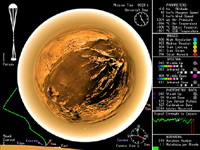
Click on the image for QuickTime Movie of
Titan Descent Data Movie with Bells and WhistlesThis movie, built with data collected during the European Space Agency's Huygens probe on Jan. 14, 2005, shows the operation of the Descent Imager/Spectral Radiometer camera during its descent and after touchdown. The camera was funded by NASA.
The almost four-hour-long operation of the camera is shown in less than five minutes. That's 40 times the actual speed up to landing and 100 times the actual speed thereafter.
The first part of the movie shows how Titan looked to the camera as it acquired more and more images during the probe's descent. Each image has a small field of view, and dozens of images were made into mosaics of the whole scene.
The scientists analyzed Huygens' speed, direction of motion, rotation and swinging during the descent. The movie includes sidebar graphics that show:
- (Lower left corner) Huygens' trajectory views from the south, a scale bar for comparison to the height of Mount Everest, colored arrows that point to the sun and to the Cassini orbiter.
- (Top left corner) A close-up view of the Huygens probe highlighting large and unexpected parachute movements, a scale bar for comparison to human height.
- (Lower right corner) A compass that shows the changing direction of view as Huygens rotates, along with the relative positions of the sun and Cassini.
- (Upper right corner) A clock that shows Universal Time for Jan. 14, 2005 (Universal Time is 7 hours ahead of Pacific Daylight Time). Above the clock, events are listed in mission time, which starts with the deployment of the first of the three parachutes.
Sounds from a left speaker trace Huygens' motion, with tones changing with rotational speed and the tilt of the parachute. There also are clicks that clock the rotational counter, as well as sounds for the probe's heat shield hitting Titan's atmosphere, parachute deployments, heat shield release, jettison of the camera cover and touchdown.
Sounds from a right speaker go with the Descent Imager/Spectral Radiometer activity. There's a continuous tone that represents the strength of Huygens' signal to Cassini. Then there are 13 different chimes - one for each of instrument's 13 different science parts - that keep time with flashing-white-dot exposure counters. During its descent, the Descent Imager/Spectral Radiometer took 3,500 exposures.
The Huygens probe was delivered to Saturn's moon Titan by the Cassini spacecraft, which is managed by NASA's Jet Propulsion Laboratory, Pasadena, Calif. NASA supplied two instruments on the probe, the descent imager/spectral radiometer and the gas chromatograph mass spectrometer.
The Cassini-Huygens mission is a cooperative project of NASA, the European Space Agency and the Italian Space Agency. The Jet Propulsion Laboratory, a division of the California Institute of Technology in Pasadena, manages the mission for NASA's Science Mission Directorate, Washington, D.C. The descent imager/spectral radiometer team is based at the University of Arizona, Tucson.
For more information about the Cassini-Huygens mission visit http://saturn.jpl.nasa.gov/home/index.cfm
.

